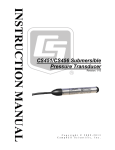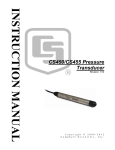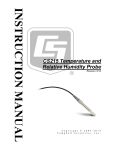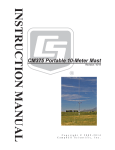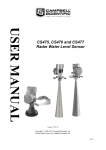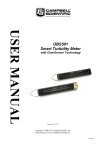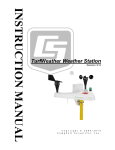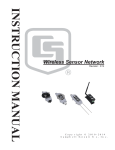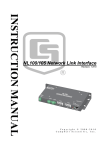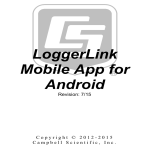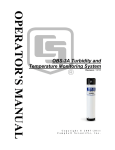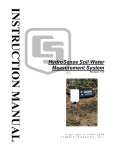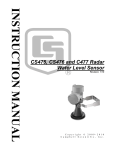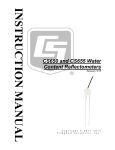Download Campbell CS451 Instruction manual
Transcript
INSTRUCTION MANUAL CS451/CS456 Submersible Pressure Transducer Revision: 4/15 C o p y r i g h t © 2 0 0 9 - 2 0 1 5 C a m p b e l l S c i e n t i f i c , I n c . Assistance Products may not be returned without prior authorization. The following contact information is for Canadian and international clients residing in countries served by Campbell Scientific (Canada) Corp. directly. Affiliate companies handle repairs for clients within their territories. Please visit www.campbellsci.ca to determine which Campbell Scientific company serves your country. To obtain a Returned Materials Authorization (RMA), contact CAMPBELL SCIENTIFIC (CANADA) CORP., phone (780) 454-2505. After a measurement consultant determines the nature of the problem, an RMA number will be issued. Please write this number clearly on the outside of the shipping container. Campbell Scientific’s shipping address is: CAMPBELL SCIENTIFIC (CANADA) CORP. RMA#_____ 14532 131 Avenue NW Edmonton, Alberta T5L 4X4 Canada For all returns, the client must fill out a “Statement of Product Cleanliness and Decontamination” form and comply with the requirements specified in it. The form is available from our web site at www.campbellsci.ca/repair. A completed form must be either emailed to [email protected] or faxed to (780) 454-2655. Campbell Scientific (Canada) Corp. is unable to process any returns until we receive this form. If the form is not received within three days of product receipt or is incomplete, the product will be returned to the client at the client’s expense. Campbell Scientific (Canada) Corp.f reserves the right to refuse service on products that were exposed to contaminants that may cause health or safety concerns for our employees. Precautions DANGER — MANY HAZARDS ARE ASSOCIATED WITH INSTALLING, USING, MAINTAINING, AND WORKING ON OR AROUND TRIPODS, TOWERS, AND ANY ATTACHMENTS TO TRIPODS AND TOWERS SUCH AS SENSORS, CROSSARMS, ENCLOSURES, ANTENNAS, ETC. FAILURE TO PROPERLY AND COMPLETELY ASSEMBLE, INSTALL, OPERATE, USE, AND MAINTAIN TRIPODS, TOWERS, AND ATTACHMENTS, AND FAILURE TO HEED WARNINGS, INCREASES THE RISK OF DEATH, ACCIDENT, SERIOUS INJURY, PROPERTY DAMAGE, AND PRODUCT FAILURE. TAKE ALL REASONABLE PRECAUTIONS TO AVOID THESE HAZARDS. CHECK WITH YOUR ORGANIZATION'S SAFETY COORDINATOR (OR POLICY) FOR PROCEDURES AND REQUIRED PROTECTIVE EQUIPMENT PRIOR TO PERFORMING ANY WORK. Use tripods, towers, and attachments to tripods and towers only for purposes for which they are designed. Do not exceed design limits. Be familiar and comply with all instructions provided in product manuals. Manuals are available at www.campbellsci.ca or by telephoning (780) 454-2505 (Canada). You are responsible for conformance with governing codes and regulations, including safety regulations, and the integrity and location of structures or land to which towers, tripods, and any attachments are attached. Installation sites should be evaluated and approved by a qualified personnel (e.g. engineer). If questions or concerns arise regarding installation, use, or maintenance of tripods, towers, attachments, or electrical connections, consult with a licensed and qualified engineer or electrician. General x Prior to performing site or installation work, obtain required approvals and permits. x Use only qualified personnel for installation, use, and maintenance of tripods and towers, and any attachments to tripods and towers. The use of licensed and qualified contractors is highly recommended. x Read all applicable instructions carefully and understand procedures thoroughly before beginning work. x Wear a hardhat and eye protection, and take other appropriate safety precautions while working on or around tripods and towers. x Do not climb tripods or towers at any time, and prohibit climbing by other persons. Take reasonable precautions to secure tripod and tower sites from trespassers. x Use only manufacturer recommended parts, materials, and tools. Utility and Electrical x You can be killed or sustain serious bodily injury if the tripod, tower, or attachments you are installing, constructing, using, or maintaining, or a tool, stake, or anchor, come in contact with overhead or underground utility lines. x Maintain a distance of at least one-and-one-half times structure height, 6 meters (20 feet), or the distance required by applicable law, whichever is greater, between overhead utility lines and the structure (tripod, tower, attachments, or tools). x Prior to performing site or installation work, inform all utility companies and have all underground utilities marked. x Comply with all electrical codes. Electrical equipment and related grounding devices should be installed by a licensed and qualified electrician. Elevated Work and Weather x Exercise extreme caution when performing elevated work. x Use appropriate equipment and safety practices. x During installation and maintenance, keep tower and tripod sites clear of un-trained or nonessential personnel. Take precautions to prevent elevated tools and objects from dropping. x Do not perform any work in inclement weather, including wind, rain, snow, lightning, etc. Maintenance x Periodically (at least yearly) check for wear and damage, including corrosion, stress cracks, frayed cables, loose cable clamps, cable tightness, etc. and take necessary corrective actions. x Periodically (at least yearly) check electrical ground connections. WHILE EVERY ATTEMPT IS MADE TO EMBODY THE HIGHEST DEGREE OF SAFETY IN ALL CAMPBELL SCIENTIFIC PRODUCTS, THE CLIENT ASSUMES ALL RISK FROM ANY INJURY RESULTING FROM IMPROPER INSTALLATION, USE, OR MAINTENANCE OF TRIPODS, TOWERS, OR ATTACHMENTS TO TRIPODS AND TOWERS SUCH AS SENSORS, CROSSARMS, ENCLOSURES, ANTENNAS, ETC. PLEASE READ FIRST About this manual Please note that this manual was originally produced by Campbell Scientific Inc. (CSI) primarily for the US market. Some spellings, weights and measures may reflect this origin. Some useful conversion factors: Area: Length: Mass: Pressure: Volume: 1 in2 (square inch) = 645 mm2 1 in. (inch) = 25.4 mm 1 ft (foot) = 304.8 mm 1 yard = 0.914 m 1 mile = 1.609 km 1 oz. (ounce) = 28.35 g 1 lb (pound weight) = 0.454 kg 1 psi (lb/in2) = 68.95 mb 1 US gallon = 3.785 litres In addition, part ordering numbers may vary. For example, the CABLE5CBL is a CSI part number and known as a FIN5COND at Campbell Scientific Canada (CSC). CSC Technical Support will be pleased to assist with any questions. About sensor wiring Please note that certain sensor configurations may require a user supplied jumper wire. It is recommended to review the sensor configuration requirements for your application and supply the jumper wire is necessary. Table of Contents PDF viewers: These page numbers refer to the printed version of this document. Use the PDF reader bookmarks tab for links to specific sections. 1. Introduction ................................................................. 1 2. Cautionary Statements ............................................... 1 3. Initial Inspection ......................................................... 1 4. Quickstart .................................................................... 2 5. Overview ...................................................................... 5 6. Specifications ............................................................. 6 7. Installation ................................................................... 8 7.1 Installation Considerations ................................................................... 8 7.1.1 Transducer Position ...................................................................... 8 7.1.2 Vent Tube ..................................................................................... 8 7.1.3 Appropriate Water Depth .............................................................. 9 7.1.4 Dislodging Bubbles....................................................................... 9 7.2 Installation Procedure .......................................................................... 9 7.2.1 Lower to depth .............................................................................. 9 7.2.2 Secure the Transducer ................................................................... 9 7.2.2.1 Tie Wrap/Tape.................................................................... 9 7.2.2.2 Split Mesh Cable Grip ...................................................... 10 7.2.3 Measure the Initial Elevation ...................................................... 10 7.2.4 Offset Calculation ....................................................................... 10 7.3 Wiring ................................................................................................ 11 7.3.1 SDI-12 Datalogger Connections ................................................. 11 7.3.2 RS-232 Connections ................................................................... 11 7.3.3 A150/CWS900 ............................................................................ 12 7.4 Programming...................................................................................... 12 8. Operation ................................................................... 13 8.1 Configuration ..................................................................................... 13 8.1.1 PC Connection Using the A200 .................................................. 13 8.1.1.1 Driver Installation ............................................................ 13 8.1.1.2 A200 Wiring..................................................................... 13 8.1.1.3 Powering the Sensor ......................................................... 14 8.1.1.4 Determining which COM Port the A200 has been Assigned ....................................................................... 14 8.1.2 Device Configuration Utility (version 2.03 or higher) ................ 15 8.2 SDI-12 Commands............................................................................. 16 8.3 Measuring Multiple SDI-12 Sensors .................................................. 17 i Table of Contents 9. Maintenance ..............................................................17 9.1 9.2 Every Visit ........................................................................................ 17 Every Two to Three Years or on a Rotating Schedule ...................... 17 10. Troubleshooting ........................................................18 Appendices A. Importing Short Cut Code into a Program Editor ..................................................................... A-1 B. Example Programs.................................................. B-1 B.1 CRBasic Programs .......................................................................... B-1 B.1.1 Example Program for CR200(X)-Series Datalogger ................ B-1 B.1.2 Example Program for CR1000 Datalogger .............................. B-2 C. Calibration Certificate ............................................. C-1 D. SDI-12 Sensor Support ........................................... D-1 D.1 SDI-12 Command Basics ................................................................ D-1 D.1.1 Address Query Command (?!) ................................................. D-1 D.1.2 Change Address Command (aAb!) .......................................... D-1 D.1.3 Send Identification Command (aI!) .......................................... D-2 D.1.4 Start Measurement Commands (aM!) ...................................... D-2 D.1.5 Aborting a Measurement Command ........................................ D-2 D.1.6 Send Data Command (aDv!) .................................................... D-2 D.2 SDI-12 Transparent Mode ............................................................... D-3 D.2.1 CR200(X) Series Datalogger Example .................................... D-3 D.2.2 CR1000 Datalogger Example................................................... D-4 D.3 Advanced SDI-12 Commands ......................................................... D-5 E. RS-232 Connection Via PC Terminal Software ..... E-1 Figures 5-1. 7-1. 7-2. 8-1. 8-2. D-1. D-2. E-1. CS451 nose cone options .................................................................... 6 Transducer suspended with split mesh cable grip ............................. 10 A150 wired for CS451 pressure sensor and CWS900 connector ...... 12 A200 Sensor-to-PC Interface ............................................................ 14 Connect screen .................................................................................. 15 CR200(X) example of using the SDI-12 transparent mode to change the SDI-12 address from 0 to 1. ....................................... D-4 CR1000 example of using the SDI-12 transparent mode to change the SDI-12 address from 3 to 1. Sensor is connected to control port 1............................................................................ D-5 Terminal Emulator ........................................................................... E-2 ii Table of Contents Tables 7-1. 7-2. 8-1. 8-2. 8-3. D-1. D-2. E-1. E-2. SDI-12 Wiring ................................................................................... 11 RS-232 Wiring ................................................................................... 11 Factory Settings ................................................................................. 13 A200 Wiring ...................................................................................... 14 SDI-12 Commands............................................................................. 16 SDI-12 Command and Response Set .............................................. D-1 SDI-12 Commands.......................................................................... D-3 RS-232 Settings ............................................................................... E-1 RS-232 Terminal Commands ........................................................... E-2 iii Table of Contents iv CS451/CS456 Submersible Pressure Transducer 1. Introduction The CS451/CS456 Submersible Pressure Transducer provides pressure and temperature measurements. It uses the SDI-12 or RS-232 communications protocols to communicate with an SDI-12 or RS-232 recorder simplifying installation and programming. The CS450/CS455 can be used with an A150 desiccated case allowing the transducer to be connected to a CWS900 wireless sensor or prewired enclosure. NOTE 2. 3. This manual provides information only for CRBasic dataloggers. It is also compatible with most of our retired Edlog dataloggers. For Edlog datalogger support, see an older manual at www.campbellsci.com/old-manuals or contact a Campbell Scientific application engineer for assistance. Cautionary Statements x READ AND UNDERSTAND the Precautions section at the front of this manual. x Sensor will be damaged if it is encased in frozen liquid. x Although the CS451/CS456 is rugged, it is also a highly precise scientific instrument and should be handled as such. There are no user-serviceable parts and any attempt to disassemble the device will void the warranty. x Dropping the instrument or allowing it to “free fall” down a well may damage the transducer. x Never suspend the CS451/CS456 from the connections at the top end of the cable. Sharp bends or excessive pinching of the cable can cause damage and may pinch off the vent tube causing measurement errors. x Confirm the compatibility of the sensor and cable to non-water environments before installation. x The CS456 instead of the CS451 should be used in harsh water applications, including salt water. Initial Inspection x Upon receipt of the CS451/CS456, inspect the packaging for any signs of shipping damage and, if found, report the damage to the carrier in accordance with policy. The contents of the package should also be inspected and a claim filed if any shipping related damage is discovered. 1 CS451/CS456 Submersible Pressure Transducer 4. x The model number and pressure range is etched on the housing and the cable length is printed on the label near the connection end of the cable. Check this information against the shipping documentation to ensure that the expected product was received. x Ensure that the desiccant tube is attached to the vent tube on the cable. The desiccant should be blue; replace if it is another color. Quickstart Short Cut is an easy way to program your datalogger to measure the sensor and assign datalogger wiring terminals. The following procedure shows using Short Cut to program the CS451/CS456. 2 1. Install Short Cut by clicking on the install file icon. Get the install file from either www.campbellsci.com, the ResourceDVD, or find it in installations of LoggerNet, PC200W, PC400, or RTDAQ software. 2. The Short Cut installation should place a Short Cut icon on the desktop of your computer. To open Short Cut, click on this icon. 3. When Short Cut opens, select New Program. CS451/CS456 Submersible Pressure Transducer 4. Select Datalogger Model and Scan Interval (60 second or higher scan interval is recommended). Click Next. 5. Under the Available Sensors and Devices list, select the Sensors | Water | Level & Flow folder. Select CS450/CS455 Pressure Transducer, click to move the selection to the Selected device window. Water level defaults to feet and temperature defaults to degrees Celsius. These can be changed by clicking the Water Level or Temperature box and selecting a different option. Typically, the default SDI-12 address of 0 is used. 3 CS451/CS456 Submersible Pressure Transducer 6. Under the Available Sensors and Devices list, select the Sensors | Water | Level & Flow folder. Select Offset Calculation, click to move the selection to the Selected device window, then select Lvl_ft for the Linked Level and enter the initial water level in the Observed Level Reading box. 7. 4 After selecting the sensor and offset calculation, click at the left of the screen on Wiring Diagram to see how the sensor is to be wired to the datalogger. The wiring diagram can be printed out now or after more sensors are added. CS451/CS456 Submersible Pressure Transducer 8. Select any other sensors you have, then finish the remaining Short Cut steps to complete the program. The remaining steps are outlined in Short Cut Help, which is accessed by clicking on Help | Contents | Programming Steps. 9. If LoggerNet, PC400, or PC200W is running on your PC, and the PC to datalogger connection is active, you can click Finish in Short Cut and you will be prompted to send the program just created to the datalogger. 10. If the sensor is connected to the datalogger, as shown in the wiring diagram in step 7, check the output of the sensor in the datalogger support software data display to make sure it is making reasonable measurements. 5. Overview The CS451/CS456 pressure transducer provides a reliable, accurate pressure/level measurement that is fully temperature compensated. Its 24 bit A/D has simultaneous 50/60 Hz rejection and automatic calibration for each measurement. A number of additional advanced measurement techniques are employed to harness the best possible performance available from today’s state-of-the-art pressure transducer technology. The transducer reverts to a low power sleep state between measurements. A series of measurements are performed yielding a temperature and pressure value. This measurement cycle takes less than 1.5 second. The transducer can also be configured to output pressure only in less than 1 second. The measurement cycle is activated using SDI-12 or RS-232 commands. The transducer consists of a piezoresistive sensor housed in a 316L stainlesssteel (CS451) or titanium (CS456) package to enhance reliability. The rugged construction makes the CS451/CS456 suitable for water level measurement in irrigation applications, water wells, lakes, streams, and tanks. The titanium package of the CS456 makes it ideal for salt water or other harsh environments. The cable incorporates a vent tube to compensate for atmospheric pressure fluctuations and the jacket is made of rugged Hytrel®, designed to remain flexible and tough, even under harsh environmental conditions. The CS451/CS456 has two communication options: SDI-12 or RS-232. The CS451/CS456 is shipped from the factory with both communications options enabled; there is no configuration required. As an SDI-12 sensor, the CS451/CS456 is shipped with an address of 0. Two values are output by the CS451/CS456—pressure/level and temperature. The CS451/CS456 is shipped from the factory to output pressure in psig and temperature in degrees Celsius. The CS451/CS456 has three nose cone options. FIGURE 5-1 shows the nose cone options. The weighted nose cone makes the transducer easier to submerge to depth. The 1/4 inch NPT nose cone allows the transducer to be used in closed-pipe applications. Nose cones can be switched out later. The –L in the transducer’s model name indicates user-specified cable length. 5 CS451/CS456 Submersible Pressure Transducer Standard Nose Cone Weighted Nose Cone 1/4 inch NPT Nose Cone FIGURE 5-1. CS451 nose cone options 6. Specifications Features: x Output acceptable for recording devices with SDI-12 or RS-232 capability including Campbell Scientific dataloggers x Quality construction that ensures product reliability x Rugged stainless steel or titanium case that protects piezoresistive sensor x Fully temperature compensated x Low power sleep state between measurements that reduces power consumption x Weighted nose cone offered that adds 0.2 kg (7.4 oz) to the transducer’s weight. Additional weight makes submersion of the transducer easier x Compatible with Campbell Scientific CRBasic dataloggers: CR6, CR200(X) series, CR800 series, CR1000, CR3000, and CR5000 6 Power Requirements: 5 to 18 Vdc Power Consumption: Quiescent current < 50 μA Measurement/Communication Current: 8 mA for 1-s measurement Maximum Peak Current: 40 mA Measurement Time: Less than 1.5 s Outputs: SDI-12 (version 1.3) 1200 bps RS-232 9600 bps CS451/CS456 Submersible Pressure Transducer Measurement Ranges: CAUTION Pressure (psig) Pressure (kPa) Depth of fresh water 0 to 2.9 0 to 20 0 to 2 m (6.7 ft) 0 to 7.25 0 to 50 0 to 5.1 m (16.7 ft) 0 to 14.5 0 to 100 0 to 10.2 m (33.4 ft) 0 to 29 0 to 200 0 to 20.4 m (67 ft) 0 to 72.5 0 to 500 0 to 50.9 m (167 ft) 0 to 145 0 to 1000 0 to 102 m (334.5 ft) Accuracy: ±0.1% full scale range TEB* or ±0.05% full scale range TEB** Resolution: 0.0035% full scale range Overpressure: 2x pressure range Dry Storage Temperature: –10 to 80 °C Sensor will be damaged if it is encased in frozen liquid. Operating Temperature: 0 to 60 °C Temperature Accuracy: ±0.2 °C Maximum Cable Length: SDI-12 (one transducer connected to a single port): ~475 m (1500 ft) SDI-12 (10 transducers connected to a single port): 60 m (200 ft) RS-232: 60 m (200 ft) Cable Type: 5 Conductor, 26 AWG Hytrel Jacket Body Material: CS451 – 316L Stainless Steel CS456 – Titanium Element Material: CS451 – 316L Stainless Steel CS456 – Hastelloy Top Cone Material: Delrin Length: 213.36 mm (6.875 in) Diameter: 21.34 mm (0.84 in) Distance from pressure sensor interface (black line etched on housing) to: End of NPT fitting: 2.54 cm (1 in) End of standard nose cone: 2.3 cm (0.9 in) End of weighted nose cone: 9.9 cm (3.9 in) 7 CS451/CS456 Submersible Pressure Transducer Air Gap Standard and weighted nose cone: NPT fitting: Weight: 25431 Split Mesh Grip Accepts cable diameter: Breaking Strength: 0.653 cm (0.257 in) 2.72 cm (1.07 in) CS451: 0.17 kg (0.37 lb) CS456: 0.10 kg (0.23 lb) Cable: 0.421 kg/m (0.283 lb/ft) 4.57 to 6.35 mm (0.18 to 0.25 in) (~300 lb) *Total Error Band (TEB) includes the combined errors due to nonlinearity, hysteresis, nonrepeatability, and thermal effects over the compensated temperature range, per ISA S51.1. **0.05% full scale range accuracy not available in the 0 to 2.9 psig range. 7. Installation If you are programming your datalogger with Short Cut, skip Section 7.3, Wiring (p. 11), and Section 7.4, Programming (p. 12). Short Cut does this work for you. See Section 4, Quickstart (p. 2), for a Short Cut tutorial. 7.1 Installation Considerations The CS451/CS456 is designed for water level measurements. Typical applications include agricultural water level/flow, water wells, lakes, streams, and tanks. If the device is to be installed in a liquid other than water or in contaminated water, check the compatibility of the wetted material. The CS456 should be used in harsh water applications, including salt water. 7.1.1 Transducer Position The CS451/CS456 can be installed in any position; however, when it leaves the factory it is tested in the vertical position. There will be an offset error if not installed vertically; contact Campbell Scientific for more information. 7.1.2 Vent Tube A vent tube incorporated in the cable vents the sensor diaphragm to the atmosphere. This eliminates the need to compensate for changes in barometric pressure. To prevent water vapor from entering the inner cavity of the sensor, the vent tube opening terminates inside a desiccant tube. CAUTION The desiccant tube is shipped with a black cap to cover the vent hole. This cap MUST be removed prior to installation. Before installing the sensor, ensure the desiccant is blue; replace if not. The desiccant tube must always be attached to the CS451/CS456. 8 CS451/CS456 Submersible Pressure Transducer 7.1.3 Appropriate Water Depth The CS451/CS456 must be installed below the water at a fixed depth. This depth should be chosen so the water pressure will never exceed the transducer’s pressure range (twice its pressure range). CAUTION The output reading will not be correct, and the transducer can be damaged if pressure is excessive (2 x full scale). Pressure can be converted to feet of fresh water using the following simple equation: 1 psi = 2.31 feet of water For example, the maximum depth with a pressure range of 0 to 7.25 psig is 16.748 feet of water. 7.1.4 Dislodging Bubbles While submersing the transducer, air bubbles may become trapped between the pressure plate and the water surface, causing small offset errors until the bubbles dissolve. Dislodge these bubbles by gently shaking the CS451/CS456 while under water. 7.2 CAUTION If bubbles are not removed by rotation and shaking underwater (or bleeding out the air in a closed system), the CS451/CS456 reading will drift lower by the distance of the gap as the bubbles are slowly dissolved into the water over time. CAUTION Hitting against the well casing or other solid surface could damage the transducer. Installation Procedure 7.2.1 Lower to depth Lower the transducer to an appropriate depth. CAUTION Do not drop the instrument or allow it to “free fall” down a well as this may damage the sensor. With long drops, it may be necessary to use the weighted nose cone (option -WN). 7.2.2 Secure the Transducer 7.2.2.1 Tie Wrap/Tape The transducer body can be strapped with tie wraps or tape. Campbell Scientific offers cable ties (pn 7421) that can be used to secure and strain relief 9 CS451/CS456 Submersible Pressure Transducer the cable. If installing in a well, fasten the cable to the well head. Wrap the cable ties around the cable jacket. CAUTION Never suspend the CS451/CS456 from the connections at the top of the cable. Sharp bends or excessive pinching of the cable can cause damage and may pinch off the vent tube causing measurement errors. 7.2.2.2 Split Mesh Cable Grip The 25431 Split Mesh Cable Grip can be used to center the cable and to provide a method of suspending the cable-reducing cable stretch. It is often recommended for use in wells. FIGURE 7-1 shows a transducer’s cable suspended using the split mesh cable grip. FIGURE 7-1. Transducer suspended with split mesh cable grip 7.2.3 Measure the Initial Elevation Use a staff gauge (or other device) to measure the initial elevation of water. This value is used to calculate an offset that corrects the final measurement for errors due to zero offset or installation. SCWin will make the offset calculation. Refer to Section 7.2.4, Offset Calculation (p. 10), if not using SCWin to calculate the offset. After installation, several readings should be taken to ensure proper operations after installation. 7.2.4 Offset Calculation The pressure created is directly proportional to the water column above the sensor. An offset is used to correct the final measurement to any error due to sensor zero offset or installation. 10 CS451/CS456 Submersible Pressure Transducer For example, if the correct elevation of the water, as measured by a staff gauge or other measurement device, is 2015.50 feet, and the CS451 provides a reading of 5.76 psig, then: 5.76 psig 2.31 ft/psig = 13.3056 ft. So, the offset is calculated: 2015.50 ft – 13.3056 ft = 2002.1944 ft This offset can be accounted for in the program instruction of the SDI-12 recorder. 7.3 Wiring NOTE Power down your system before wiring the CS451/CS456. The shield wire plays an important role in noise emissions and susceptibility as well as transient protection. 7.3.1 SDI-12 Datalogger Connections TABLE 7-1. SDI-12 Wiring Color CS451/CS456 Function CR800 CR3000 CR1000 CR200(X) Series CR6 CR5000 Red +12 Vdc 12 V Battery+ 12 V 12 V Black Power Ground G G G G White SDI-12 Signal *C C1/SDI-12 C or U SDI-12 Blue GND G G G G Yellow GND G G G G Clear Shield G G G G 7.3.2 RS-232 Connections TABLE 7-2. RS-232 Wiring Color CS451/CS456 Function Connection Red +12vdc Power Source Black Power Ground Power Ground White RS-232 Tx (Output) Transmit Pin 2 Rx (Input) Blue RS-232 Rx (Input) Receive Pin 3 Tx (Output) Yellow Digital Ground Ground Pin 5 GND Clear Shield GND Ground RS-232 9-pin 11 CS451/CS456 Submersible Pressure Transducer 7.3.3 A150/CWS900 The A150 desiccated case allows the CS451/CS456 to be connected to the CWS900 wireless sensor and then used in a wireless network. FIGURE 7-2 shows the CS451 wired to the A150’s terminal block. The 26972 cable is included with the A150. FIGURE 7-2. A150 wired for CS451 pressure sensor and CWS900 connector 7.4 Programming Short Cut is the best source for up-to-date datalogger programming code. Programming code is needed, x x when creating a program for a new datalogger installation when adding sensors to an existing datalogger program If your data acquisition requirements are simple, you can probably create and maintain a datalogger program exclusively with Short Cut. If your data acquisition needs are more complex, the files that Short Cut creates are a great source for programming code to start a new program or add to an existing custom program. NOTE Short Cut cannot edit programs after they are imported and edited in CRBasic Editor. A Short Cut tutorial is available in Section 4, Quickstart (p. 2). If you wish to import Short Cut code into CRBasic Editor to create or add to a customized program, follow the procedure in Appendix A, Importing Short Cut Code into a Program Editor (p. A-1). Programming basics for CRBasic dataloggers are provided in the following sections. Complete program examples for select CRBasic dataloggers can be found in Appendix B, Example Programs (p. B-1). Programming basics and programming examples for Edlog dataloggers are provided at www.campbellsci.com\old-manuals. The SDI12Recorder() measurement instruction programs CRBasic dataloggers (CR6, CR200(X)-series, CR800-series, CR1000, CR3000, and CR5000) to measure the CS451/CS456 sensor. This instruction sends a request to the sensor to make a measurement and then retrieves the measurement from the sensor. See Section 8.2, SDI-12 Commands (p. 16), for more information. 12 CS451/CS456 Submersible Pressure Transducer When using a CR200(X), the SDI12Recorder() instruction has the following syntax: SDI12Recorder(Destination,OutString,Multiplier,Offset) For the other CRBasic dataloggers, the SDI12Recorder() instruction has the following syntax: SDI12Recorder(Destination, SDIPort, SDIAddress, “SDICommand”, Multiplier, Offset) 8. Operation 8.1 Configuration TABLE 8-1 shows default settings of the CS451/CS456. TABLE 8-1. Factory Settings SDI-12 Address 0 RS-232 Baud Rate 9600 Pressure/Level Units psig Temperature Units Celsius Communicating with the CS451/CS456 requires the sensor to be either connected to a PC or to an SDI-12 recorder. The sensor typically connects to a PC via the A200 sensor to PC interface. Many SDI-12 recorders allow communication to the sensor via a terminal screen. Configurable settings can be changed via SDI-12 commands or by using Campbell Scientific’s software Device Configuration Utility (DevConfig). 8.1.1 PC Connection Using the A200 The A200 or another device is required to connect the CS451/CS456 to a PC. This allows sensor settings to be changed via DevConfig. 8.1.1.1 Driver Installation If the A200 has not been previously plugged into your PC and your PC operating system is not Windows 7, the A200 driver needs to be loaded onto your PC. NOTE Drivers should be loaded before plugging the A200 into the PC. The A200 drivers can be downloaded, at no charge, from: www.campbellsci.com/downloads. 8.1.1.2 A200 Wiring One end of the A200 has a terminal block while the other end has a type B female USB port. The terminal block provides 12V, G, TX, and RX terminals for connecting the sensor (see FIGURE 8-1 and TABLE 8-2). A data cable (pn 17648) ships with the A200. This cable has a USB type-A male connector that 13 CS451/CS456 Submersible Pressure Transducer attaches to a PC’s USB port, and a type B male connector that attaches to the A200’s USB port. FIGURE 8-1. A200 Sensor-to-PC Interface TABLE 8-2. A200 Wiring Color Sensor Cable Label A200 Terminal Red 12V +12Vdc Black G G White C Tx Blue G Rx Yellow G G Clear Signal Ground G 8.1.1.3 Powering the Sensor The A200 provides power to the sensor when it is connected to a PC’s USB port. An internal DC/DC converter boosts the 5 Vdc supply from the USB connection to a 12 Vdc output is required to power the sensor. 8.1.1.4 Determining which COM Port the A200 has been Assigned When the A200 driver is loaded, the A200 is assigned a COM port number. This COM port number is needed when using DevConfig or a PC terminal software such as HyperTerminal. Often, the assigned COM port will be the next port number that is free. However, if other devices have been installed in the past (some of which may no longer be plugged in), the A200 may be assigned a higher COM port number. To check which COM port has been assigned to the A200, watch for the appearance of a new COM port in the list of COM ports offered in the software 14 CS451/CS456 Submersible Pressure Transducer package (e.g., LoggerNet) before and after the installation, or look in the Windows Device Manager list under the ports section (access via the control panel). 8.1.2 Device Configuration Utility (version 2.03 or higher) The Device Configuration Utility (DevConfig) allows you to change the settings of the CS451/CS456. DevConfig is shipped on the Campbell Scientific ResourceDVD included with the CS451/CS456. To use DevConfig, the transducer needs to be connected to the PC via the A200 (see Section 8.1.1, PC Connection Using the A200 (p. 13)). After installing DevConfig and connecting the transducer to the PC, select CS451 from the Device Type list on the left column of the screen. In the PC Serial Port box, select the COM port that was assigned to the A200 (see Section 8.1.1.4, Determining which COM Port the A200 has been Assigned (p. 14)). Click on the Connect button to enable communication with the sensor. Once successfully connected, the screen should look like FIGURE 8-2. FIGURE 8-2. Connect screen There are three settings that can be changed: SDI-12 address, Pressure/Level Units, and Temperature Units. Double-click on the window of the units to be changed. This will open a pick menu box. Select the desired units and Apply the changes. 15 CS451/CS456 Submersible Pressure Transducer 8.2 SDI-12 Commands NOTE This section briefly describes using the SDI-12 commands. Additional SDI-12 information is available at Appendix D, SDI(p. D-1), www.sdi-12.org, or 12 Sensor Support www.youtube.com/user/CampbellScientific. The CS451/CS456 uses an SDI-12 compatible hardware interface and supports a subset of the SDI-12 commands. The most commonly used command is the aM! command, issued by the datalogger, where a represents the sensor address. The communication sequence begins with the datalogger waking the sensor and issuing the aM! command. The transducer responds to the datalogger indicating that two measurements will be ready within two seconds. Subsequent communications handle data reporting from the sensor to the datalogger. The SDI-12 protocol has the ability to support various measurement commands. The CS451/CS456 supports the commands that are listed in TABLE 8-3. TABLE 8-3. SDI-12 Commands SDI-12 Command Command Function Values Returned aM! Configured settings Pressure/Level, Temperature aM1! PSIG, °C Pressure, Temperature aM2! PSIG, °F Pressure, Temperature aM3! kPa, °C Pressure, Temperature aM4! kPa, °F Pressure, Temperature aM5! Sensor’s Serial Number Serial Number aM6! Ohms, ohms, °C 'R, Rb, Temperature (°C), IN – DAC counts singleended measurement, IN+ DAC counts singleended measurement, OUT DAC counts differential measurement aM7! Configured settings (provides data in less than 0.8 seconds) Pressure/Level aM8! Configured settings (provides average of data based on user selected samples) Pressure/Level, Temperature As measurement data is transferred between the probe and datalogger digitally, there are no offset errors incurred with increasing cable length as seen with analog sensors. However, with increasing cable length, there is still a point 16 CS451/CS456 Submersible Pressure Transducer when digital communications break down, resulting in either no response or excessive SDI-12 retries and incorrect data due to noise problems. (Using SDI-12 commands like aMC!, which adds a CRC check, can significantly improve incorrect data issues.) 8.3 Measuring Multiple SDI-12 Sensors Up to ten CS451/CS456 sensors or other SDI-12 sensors can be connected to a single datalogger control port. Each SDI-12 device must have a unique SDI-12 address of 0 and 9, A to Z, or a to z. See Appendix D, SDI-12 Sensor Support (p. D-1), for more information. 9. Maintenance Campbell Scientific recommends that the CS451/CS456 be factory recalibrated and checked every 24 months. Before a CS451/CS456 sensor is sent to Campbell Scientific, the customer must get an RMA (returned material authorization) number, and fill out the Declaration of Hazardous Material and Decontamination form. The CS451/CS456 has no user-serviceable parts. Cable can be damaged by abrasion, rodents, sharp objects, twisting, crimping or crushing, and pulling. Take care during installation and use to avoid cable damage. If a section of cable is damaged, it is recommended that you send your sensor back to replace the bale harness assembly. Periodic evaluation of the desiccant is vital for keeping the vent tube dry. The CS451/CS456 ships with the desiccant tube attached. To assess the effectiveness of the desiccant, use one of the following: 9.1 9.2 x The desiccant in the tube changes color from blue to pink when the drying power is lost. x The Enclosure Accessory Humidity Indicator Card (pn 28878). Every Visit x Collect data. x Visually inspect wiring and physical conditions. x Check indicating desiccant or enclosure humidity indicator; service if necessary. x Check battery condition (inspect physical appearance and use a keyboard display, PDA, or laptop to view the battery voltage). x Check all sensor readings; adjust transducer offsets if necessary. x Check recent data. Every Two to Three Years or on a Rotating Schedule x Send the CS451/CS456 in for inspection. 17 CS451/CS456 Submersible Pressure Transducer 10. Troubleshooting The most common causes for erroneous pressure transducer data include: x poor sensor connections to the datalogger x damaged cables x damaged transducers x moisture in the vent tube Problem: Unit will not respond when attempting serial communications. Suggestion: Check the power (red is +V and black is ground) and signal (white is SDI-12 data) lines to ensure proper connection to the datalogger. Check the datalogger program to ensure that the same port the SDI-12 data line is connected to is specified in the measurement instruction. Problem: Transducer appears to be operating properly but data shows a periodic or cyclic fluctuation not attributable to water level changes. Suggestion: A kinked or plugged vent tube will not effectively vent a gauge pressure (Vented) type of device. Normal changes in barometric pressure will appear as water level fluctuations and these types of errors are typically on the order of 1 foot of water level. If the desiccant chamber has not been properly maintained, water may have condensed in the vent tube and the device should be returned to the factory for service. 18 Appendix A. Importing Short Cut Code into a Program Editor This tutorial shows: x How to import a Short Cut program into a program editor for additional refinement x How to import a wiring diagram from Short Cut into the comments of a custom program Short Cut creates files that can be imported into either CRBasic Editor program editor. These files normally reside in the C:\campbellsci\SCWin folder and have the following extensions: x x x x x x .DEF (wiring and memory usage information) .CR2 (CR200(X) datalogger code) .CR1 (CR1000 datalogger code) .CR8 (CR800 datalogger code) .CR3 (CR3000 datalogger code) .CR5 (CR5000 datalogger code) Use the following procedure to import Short Cut code into CRBasic Editor (CR200(X), CR1000, CR800, CR3000, CR5000 dataloggers). NOTE 1. Create the Short Cut program following the procedure in Section 4, Quickstart (p. 2). Finish the program and exit Short Cut. Make note of the file name used when saving the Short Cut program. 2. Open CRBasic Editor. 3. Click File | Open. Assuming the default paths were used when Short Cut was installed, navigate to C:\CampbellSci\SCWin folder. The file of interest has a “.CR2”, “.CR1”, “.CR8”, “.CR3, or “.CR5” extension, for CR200(X), CR1000, CR800, CR3000, or CR5000 dataloggers, respectively. Select the file and click Open. 4. Immediately save the file in a folder different from \Campbellsci\SCWin, or save the file with a different file name. Once the file is edited with CRBasic Editor, Short Cut can no longer be used to edit the datalogger program. Change the name of the program file or move it, or Short Cut may overwrite it next time it is used. 5. The program can now be edited, saved, and sent to the datalogger. 6. Import wiring information to the program by opening the associated .DEF file. Copy and paste the section beginning with heading “-Wiring for CRXXX–” into the CRBasic program, usually at the head of the file. After pasting, edit the information such that a ' character (single quotation A-1 Appendix A. Importing Short Cut Code mark) begins each line. This character instructs the datalogger compiler to ignore the line when compiling the datalogger code. A-2 Appendix B. Example Programs B.1 CRBasic Programs B.1.1 Example Program for CR200(X)-Series Datalogger 'CR200(X) Series 'Declare the variable for the water level measurement Public CS451(2) 'Rename the variable names Alias CS451(1)=Level Alias CS451(2)=Temp_C 'Define a data table for 60 minute maximum and minimums DataTable(Hourly,True,-1) DataInterval(0,60,Min) Maximum(1,Level,0,0) Minimum(1,Level,0,0) Maximum(1,Temp_C,0,0) Minimum(1,Temp_C,0,0) EndTable 'Read sensor every 60 seconds BeginProg Scan(60,sec) 'Code for SDI-12 measurements: SDI12Recorder(CS451,0M!,1,0) 'Call the data table: CallTable(Hourly) NextScan EndProg B-1 Appendix B. Example Programs B.1.2 Example Program for CR1000 Datalogger 'CR1000 Series Datalogger 'Declare the variable for the water level measurement Public CS451(2) 'Rename the variable names Alias CS451(1)=Level Alias CS451(2)=Temp_C 'Define a data table for 60 minute maximum and minimums DataTable(Hourly,True,-1) DataInterval(0,60,Min,10) Maximum(1,Level,FP2,0,0) Minimum(1,Level,FP2,0,0) Maximum(1,Temp_C,FP2,0,0) Minimum(1,Temp_C,FP2,0,0) EndTable 'Read sensor every 60 seconds BeginProg Scan(60,sec,1,0) 'Code for SDI-12 measurements: SDI12Recorder(CS451,1,”0”,”M!”,1,0) 'Call the data table: CallTable(Hourly) NextScan EndProg B-2 Appendix C. Calibration Certificate Each CS451/CS456 has been calibrated to meet printed accuracy specification at multiple temperature and pressure ranges. If additional verification is required, a Calibration Certificate can be purchased for each CS451/CS456 Submersible Pressure Transducer. The calibration is done using NISTtraceable instruments. The Instrument Data Report provides a list of the pressure and temperature at which the sensor was tested. Pressure [kPa] is the pressure applied (listed in kilopascals) to the sensor. Temperature [°C] is the temperature inside the test chamber at the time of testing. Pressure After [kPa] represents the resulting measurement output by the CS451/CS456 at the give pressure and temperature. Finally, Deviation After [%F.S.], provides the difference between the actual pressure applied to the sensor and the pressure measurement output by the sensor. This value is listed as a percentage of the full scale range of the sensor. When a CS451/CS456 is returned to Campbell Scientific for calibration, the sensor will be returned with an Instrument Data Report. This report will include values in the Pressure Before [kPa] column. These values represent the measured pressure the sensor returns at the specified pressure and temperature, before calibration. C-1 Appendix C. Calibration Certificate C-2 Appendix D. SDI-12 Sensor Support D.1 SDI-12 Command Basics SDI-12 commands have three components: Sensor address (a) – a single character, and is the first character of the command. The default address of zero (0) can be used unless multiple sensors are connected to the same port. Command body (e.g., M1) – an upper case letter (the “command”) followed by alphanumeric qualifiers. Command termination (!) – an exclamation mark. An active sensor responds to each command. Responses have several standard forms and terminate with <CR><LF> (carriage return – line feed). Standard SDI-12 commands supported by the CS451/CS456 are listed in TABLE D-1. Appendix D.3, Advanced SDI-12 Commands (p. D-5), provides advanced commands. TABLE D-1. SDI-12 Command and Response Set Name Command Response Acknowledge Active a! a<CR><LF> Send Identification aI! allccccccccmmmmmmvvvxxx...xx<CR><LF> Change Address aAb! b<CR><LF> Address Query ?! a<CR><LF> Start Measurement aM! atttn<CR><LF> Send Data aD0! a<values><CR><LF> Start Verification aV! atttn D.1.1 Address Query Command (?!) Command ?! requests the address of the connected sensor. The sensor replies to the query with the address, a. D.1.2 Change Address Command (aAb!) Sensor address is changed with command aAb!, where a is the current address and b is the new address. For example, to change an address from 0 to 2, the command is 0A2!. The sensor responds with the new address b, which in this case is 2. D-1 Appendix D. SDI-12 Sensor Support D.1.3 Send Identification Command (aI!) Sensor identifiers are requested by issuing command aI!. The reply is defined by the sensor manufacturer, but usually includes the sensor address, SDI-12 version, manufacturer’s name, and sensor model information. Serial number or other sensor specific information may also be included. An example of a response from the aI! command is: 013CSI451.Std.01_12345678 Where: SDI-12 version = 1.3 Manufacturer = CSI Sensor model = 451 Operating System = .Std 01 Sensor serial number = 12345678 D.1.4 Start Measurement Commands (aM!) A measurement is initiated with M! commands. The response to each command has the form atttnn, where a = sensor address ttt = time, in seconds, until measurement data are available nn = the number of values to be returned when one or more subsequent D! commands are issued. D.1.5 Aborting a Measurement Command A measurement command (M!) is aborted when any other valid command is sent to the sensor. D.1.6 Send Data Command (aDv!) This command requests data from the sensor. It is normally issued automatically by the datalogger after measurement commands aMv!. In transparent mode, the user asserts this command to obtain data. If the expected number of data values are not returned in response to an aD0! command, the datalogger issues aD1!. TABLE D-2 shows the values returned when using the send data command. D-2 Appendix D. SDI-12 Sensor Support TABLE D-2. SDI-12 Commands SDI-12 Command Command Function Values Returned aD! Configured settings Pressure/Level, Temperature aD1! psig, °C Pressure, Temperature aD2! psig, °F Pressure, Temperature aD3! kPa, °C Pressure, Temperature aD4! kPa, °F Pressure, Temperature aD5! Sensor’s Serial Number Serial Number aD6! Ohms, ohms, °C 'R, Rb, Temperature aD7! Configured settings (provides data in less than 0.8 seconds) Pressure/Level aD8! Configured settings (provides average of data based on user selected samples) Pressure/Level, Temperature D.2 SDI-12 Transparent Mode System operators can manually interrogate and enter settings in probes using transparent mode. Transparent mode is useful in troubleshooting SDI-12 systems because it allows direct communication with probes. Datalogger security may need to be unlocked before transparent mode can be activated. Transparent mode is entered while the PC is in telecommunications with the datalogger through a terminal emulator program. It is easily accessed through Campbell Scientific datalogger support software, but is also accessible with terminal emulator programs such as Windows HyperTerminal. Datalogger keyboards and displays cannot be used. The terminal emulator is accessed by navigating to the Datalogger menu in PC200W, the Tools menu in PC400, or the Datalogger menu in the Connect screen of LoggerNet. The following examples show how to use LoggerNet software to enter transparent mode and change the SDI-12 address of a CS451/CS456 sensor. The same steps are used to enter transparent mode with PC200W and PC400 software after accessing the terminal emulator as previously described. D.2.1 CR200(X) Series Datalogger Example 1. Connect a single CS451/CS456 to the CR200(X) (see TABLE 7-1). 2. In the LoggerNet Connect screen navigate to the Datalogger menu and select Terminal Emulator. The terminal emulator window will open. In the Select Device menu, located in the lower left-hand side of the window, select the CR200Series station. D-3 Appendix D. SDI-12 Sensor Support 3. Click on the Open Terminal button. 4. Press the <enter> key until the datalogger responds with the CR2XX> prompt. At the CR2XX> prompt, make sure the All Caps Mode box is checked and enter the command SDI12 <enter>. The response SDI12> indicates that the CS451/CS456 is ready to accept SDI-12 commands. 5. To query the CS451/CS456 for its current SDI-12 address, key in ?! <enter> and the CS451/CS456 will respond with its SDI-12 address. If no characters are typed within 60 seconds, then the mode is exited. In that case, simply enter the command SDI12 again and press <enter>. 6. To change the SDI-12 address, key in aAb! <enter>, where a is the current address from the above step and b is the new address (see FIGURE D-1). The CS451/CS456 will change its address and the datalogger will respond with the new address. To exit SDI-12 transparent mode select the Close Terminal button. FIGURE D-1. CR200(X) example of using the SDI-12 transparent mode to change the SDI-12 address from 0 to 1. D.2.2 CR1000 Datalogger Example D-4 1. Connect a CS451/CS456 to the CR1000 (see TABLE 7-1). 2. In the LoggerNet Connect screen, navigate to the Datalogger menu and select Terminal Emulator. The terminal emulator window will open. In the Select Device menu, located in the lower left-hand side of the window, select the CR1000 station. 3. Click on the Open Terminal button. 4. Press the <enter> key until the datalogger responds with the CR1000> prompt. At the CR1000> prompt, make sure the All Caps Mode box is checked and enter the command SDI12 <enter>. At the Enter Cx Port 1, 3, 5, or 7 prompt, key in the control port number where the CS451/CS456 is connected and press <enter>. The response Entering SDI12 Terminal indicates that the CS451/CS456 is ready to accept SDI-12 commands. 5. To query the CS451/CS456 for its current SDI-12 address, key in ?! <enter> and the CS451/CS456 will respond with its SDI-12 address. If no Appendix D. SDI-12 Sensor Support characters are typed within 60 seconds, then the mode is exited. In that case, simply enter the command SDI12 again, press <enter>, and key in the correct control port number when prompted. 6. To change the SDI-12 address, key in aAb! <enter>, where a is the current address from the above step and b is the new address (see FIGURE D-2). The CS451/CS456 will change its address and the datalogger will respond with the new address. To exit SDI-12 transparent mode, select the Close Terminal button. FIGURE D-2. CR1000 example of using the SDI-12 transparent mode to change the SDI-12 address from 3 to 1. Sensor is connected to control port 1. D.3 Advanced SDI-12 Commands Extended SDI-12 commands can be used to configure the CS451/CS456 data output and sample number. To query the sensor for the configuration, use the aV! command followed by the aD! command. The aV! returns four values: 1. Temperature configuration where 0 = degrees C and 1 = degrees F 2. Pressure Configuration where 0=PSIg, 1= kPa, 2=bar, 3=Feet, 4=meter, 5=Inch and 6=MilliMeter 3. Multiplier 4. Offset Need to correct Appendix D.1.3, Send Identification Command (aI!) (p. D-2), Returned string: 013CampbellCS45X 001SN=12345678 Where: SDI-12 version = 1.3 Manufacturer = Campbell Sensor model = CS45X Operating System = 001 Sensor serial number = 12345678 The extended commands are used to select the temperature units (Celsius or Fahrenheit), pressure/level units (psig, kPa, bar, feet, meter, inches, or millimeter), and the integration time for each measurement. If level units are D-5 Appendix D. SDI-12 Sensor Support selected, they will represent level of fresh water. The multiplier (slope) and offset should be used to correct for relative density of water. Sample number represents the number of values used to provide the output value received by the datalogger. This output value is an average of the samples. The extended SDI-12 command used to configure output units is aXCONFIG1=tt,pp,mmm.mm,ooo.oo! where a = the SDI-12 address of the sensor, tt = temperature units, pp = measurement unit, mmm.mm = multiplier (slope), and ooo.oo = offset. Valid entries for tt (temperature) are: 0 = Celsius 1 = Fahrenheit and valid entries for pp (pressure/level) are: 0 = psig 1 = kPa 2 = bar 3 = feet 4 = meter 5 = inch 6 = millimeter Only SDI-12 instruction aM!, aM7!, and aM8! output the results obtained when using the multiplier and offset. The multiplier and offset are only applied to the pressure/level value, not to the temperature. The extended SDI-12 command used to configure sample number is aXCONFIG2=nnn!, where nnn is the number of samples that will be measured to obtain the final output value, which is an average of the samples taken. This value only applies to the aM8! command. The integration time is a result of the number of samples selected. This value can be derived by adding 2 s to the number of samples. For example, if nnn = 50, then 50 samples would be averaged. The integration time for this process is 50 plus 2, or 52 s. D-6 Appendix E. RS-232 Connection Via PC Terminal Software PC terminal software can be used to communicate with the CS451/CS456 via the RS-232 communication mode (see FIGURE E-1). The CS451/CS456 is connected to the PC via the A200 (see Section 8.1.1, PC Connection Using the A200 (p. 13)). Upon setup, the terminal emulator software will request you enter the Communication connection; defaults to a phone connection. Change the communication to appropriate “Com” in the “Connect Using” box (see Section 8.1.1.4, Determining which COM Port the A200 has been Assigned (p. 14), to determine the COM port that was assigned to the A200). The software will then prompt for the proper “Port Settings”. TABLE E-1 shows the RS-232 settings. TABLE E-1. RS-232 Settings Bits per Second 9600 Data bits 8 Parity None Stop bits 1 Flow control None You will now be able to communicate with the CS451/CS456. At the prompt, push the <Enter> key several times. This will wake-up the RS-232 mode of the sensor. TABLE E-2 shows the RS-232 commands that can be entered once it is in the RS-232 mode. NOTE By default, the CS451/CS456 is in the SDI-12 mode for communication. Once in the RS-232 mode, if there is no communication for 20 s, the sensor will return to the SDI-12 mode. E-1 Appendix E. RS-232 Connection Via PC Terminal Software FIGURE E-1. Terminal Emulator TABLE E-2. RS-232 Terminal Commands Terminal Commands E-2 Values Returned 1 Serial Number, Pressure/Level, Temperature (in configured units) 2 Serial Number, Pressure (kPa), Temperature (°C) 3 Serial Number, 'R(ohms), Rb(ohms), Temperature (°C), Element Serial Number, Product Name 5 Copyright information, OS Version and Date, Serial Number, Element Serial Number, Product Name, User Defined Name (Station Name), SDI-12 Address H or h Help menu Campbell Scientific Companies Campbell Scientific, Inc. (CSI) 815 West 1800 North Logan, Utah 84321 UNITED STATES www.campbellsci.com [email protected] Campbell Scientific Centro Caribe S.A. (CSCC) 300 N Cementerio, Edificio Breller Santo Domingo, Heredia 40305 COSTA RICA www.campbellsci.cc LQIR#FDPSEHOOVFLFF Campbell Scientific Africa Pty. Ltd. (CSAf) PO Box 2450 Somerset West 7129 SOUTH AFRICA www.csafrica.co.za [email protected] Campbell Scientific Ltd. (CSL) Campbell Park 80 Hathern Road Shepshed, Loughborough LE12 9GX UNITED KINGDOM www.campbellsci.co.uk [email protected] Campbell Scientific Australia Pty. Ltd. (CSA) PO Box 8108 Garbutt Post Shop QLD 4814 AUSTRALIA www.campbellsci.com.au [email protected] Campbell Scientific Ltd. (CSL France) 3 Avenue de la Division Leclerc 92160 ANTONY FRANCE www.campbellsci.fr [email protected] Campbell Scientific (Beijing) Co., Ltd. 8B16, Floor 8 Tower B, Hanwei Plaza 7 Guanghua Road Chaoyang, Beijing 100004 P.R. CHINA www.campbellsci.com LQIR#FDPSEHOOVFLFRPFQ Campbell Scientific Ltd. (CSL Germany) Fahrenheitstraße 13 28359 Bremen GERMANY www.campbellsci.de LQIR#FDPSEHOOVFLGH Campbell Scientific do Brasil Ltda. (CSB) Rua ApinagéVQEUņ3HUGL]HV CEP: 01258-ņSão Paulo ņ63 BRASIL www.campbellsci.com.br [email protected] Campbell Scientific Spain, S. L. (CSL Spain) Avda. Pompeu Fabra 7-9, local 1 08024 Barcelona SPAIN www.campbellsci.es [email protected] Campbell Scientific Canada Corp. (CSC) 14532 – 131 Avenue NW Edmonton AB T5L 4X4 CANADA www.campbellsci.ca [email protected] Please visit www.campbellsci.com to obtain contact information for your local US or international representative.













































